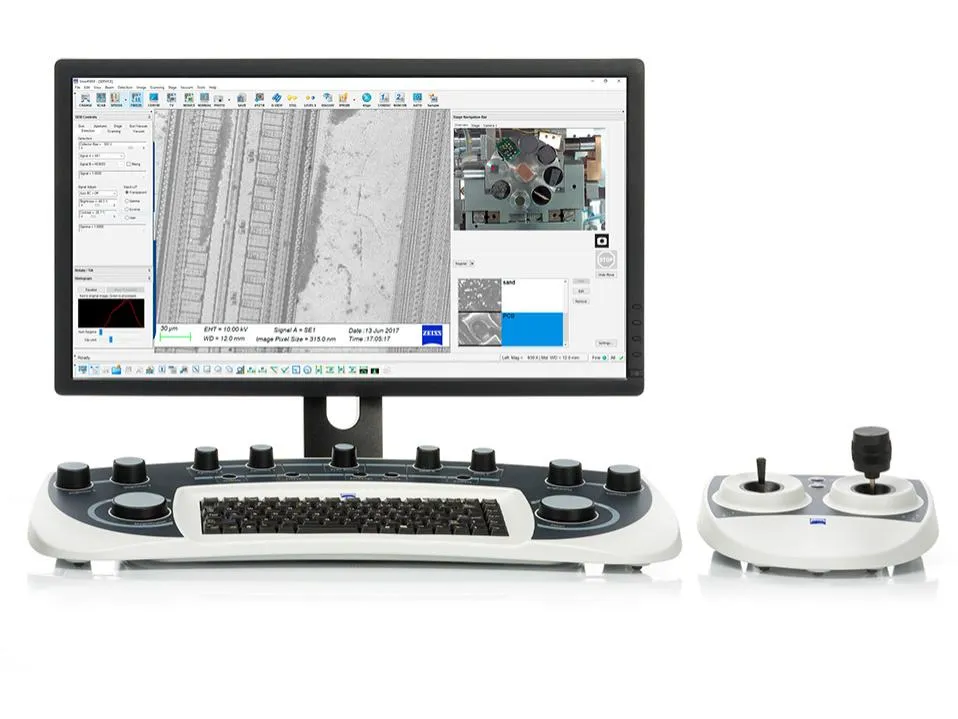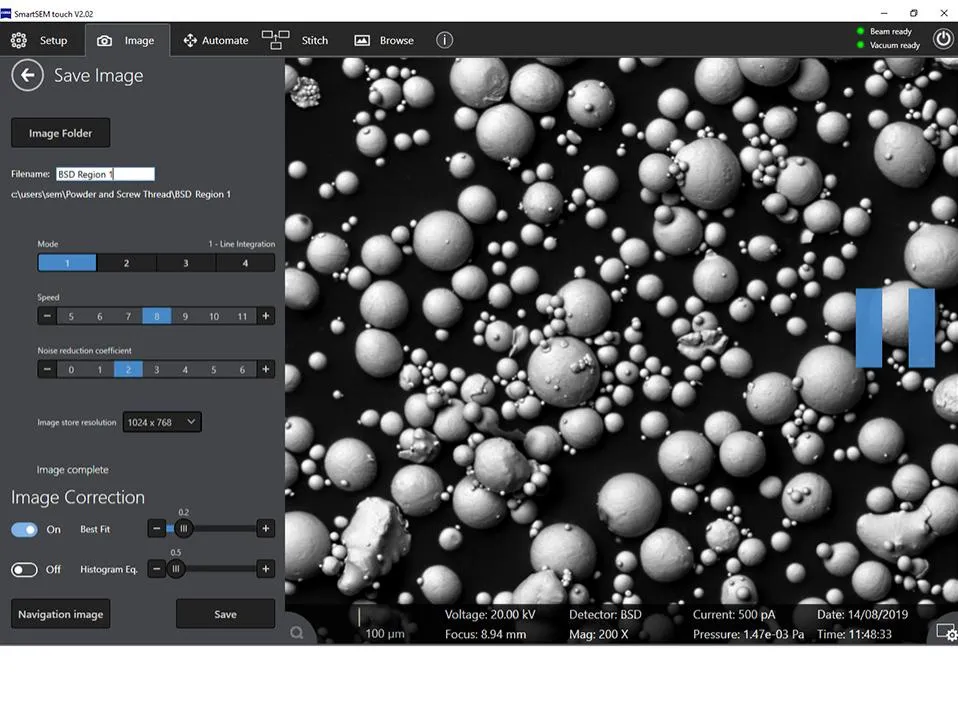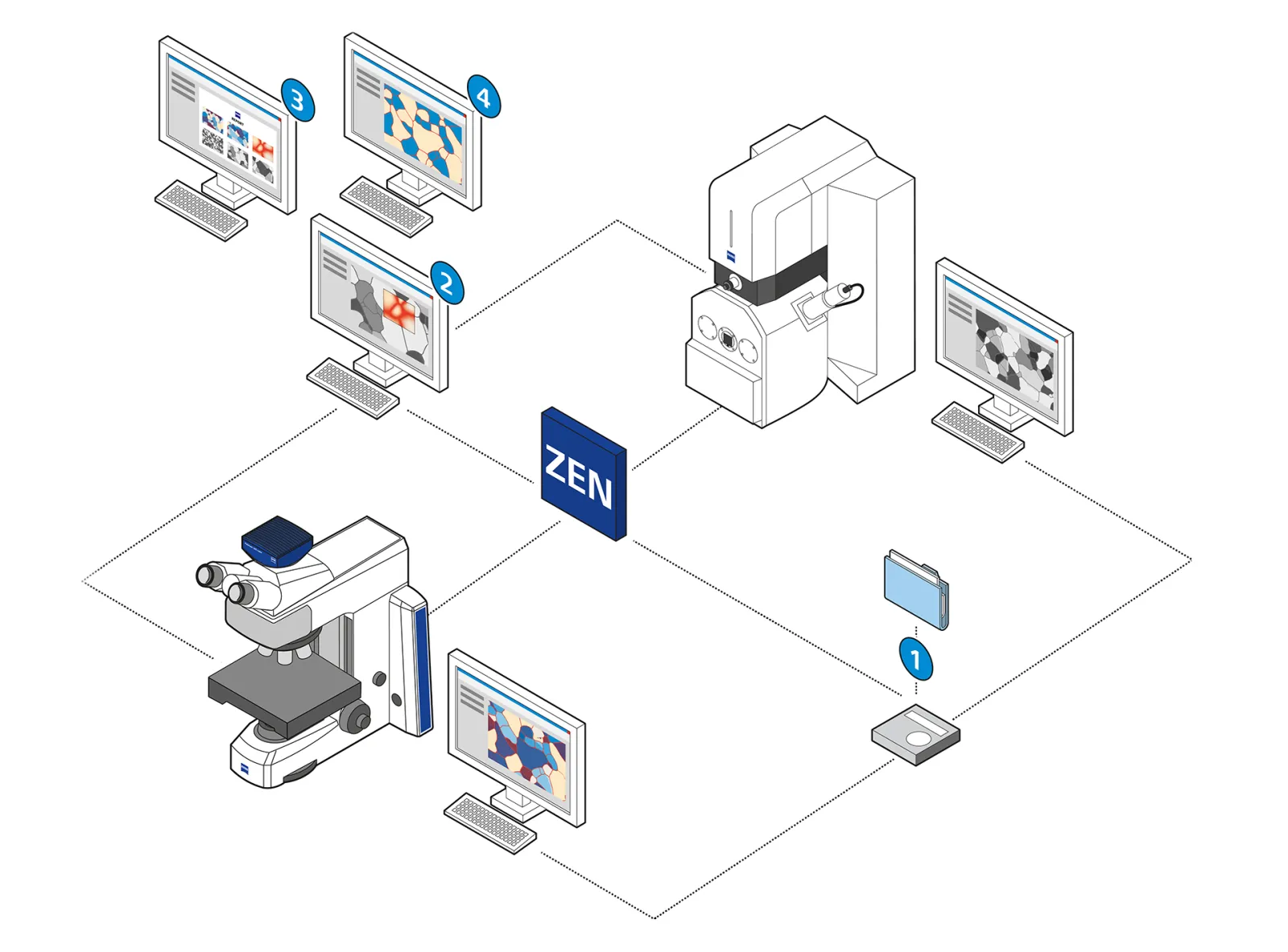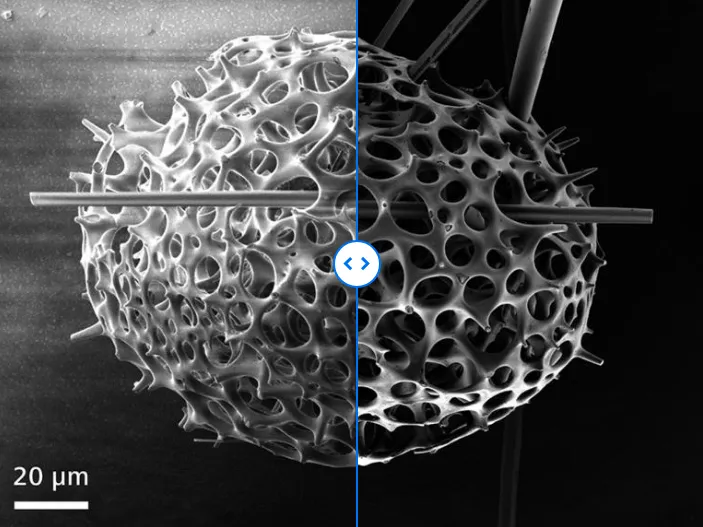

Scanning electron microscopes EVO Family
ZEISS EVO Family
The instruments of the EVO family combine high performance scanning electron microscopy with an intuitive, user-friendly experience that appeals to both trained microscopists and new users. With its comprehensive range of available options, EVO can be tailored precisely to your requirements, whether you are in life sciences, material sciences, or routine industrial quality assurance and failure analysis.
- Versatile solution for central microscopy facilities or industrial quality assurance laboratories
- Excellent images from any real-world sample
- Maximum image quality with the lanthanum hexaboride (LaB6) emitter
- Imaging and analytical excellence on non-conductive and uncoated samples
- Workflow automation and data integrity
Class-Leading Usability
SmartSEM Touch puts interactive workflow control directly at your fingertips. It is quick and easy to learn, dramatically reducing training effort and costs. Within minutes, even new users will begin capturing stunning images. This user interface also supports industrial operators who require automated workflows for repeatable inspection tasks.
Excellent Image Quality
EVO excels at extracting the maximum data quality from uncoated and unaltered samples. EVO also safeguards data quality on hydrated and heavily contaminated samples, by allowing these samples to remain in their native state. Additionally, the LaB6 emitter will give that extra bit of resolution, contrast and signal-to-noise that is important when imaging and microanalysis get challenging.

Caption: Flint, ferrocerium particle from a firelighter, imaged with ZEISS EVO, HDBSD detector.
EVO Plays Well with Others
EVO can be configured to be part of a semi-automated multi-modal workflow, with tools for seamless relocation of regions of interest and integrity of data collected from multiple modalities. Combine light and electron microscope data for material characterization or parts inspection. Or combine EVO with ZEISS light microscopes for correlative particle analysis.
Get More Hands on Deck
Depending on the actual laboratory environment, operation of the SEM can be the exclusive domain of expert electron microscopists. But this situation is challenged by the very common necessity that non-expert users, such as students, trainees, or quality engineers, also require data from the SEM. EVO takes both requirements into account, with user interface options that cater to the operational needs of experienced microscopists as well as non-micoscopists.
Expert Users. Preferred UI: SmartSEM
Expert users have access to advanced imaging parameters and analysis functions.
Novice Users. Preferred UI: SmartSEM Touch
Novice users have access to predefined workflows and the most frequently used parameters – perfect for a beginner.

Intelligent Navigation and Imaging
Improve Your Sample Throughput, Productivity and Performance
ZEISS Navigation Camera
A camera can be mounted either to the chamber to monitor the position of the samples relative to the pole piece mounted backscattered detector (chamberscope); or on the vacuum chamber door (navigation camera) to enable a helicopter view of the arrangement of samples or parts on the sample holder. This view can then be used to set up predefined locations of interest identified from a light microscope image, and for easy navigation during the entire sample investigation process.
Automated Intelligent Imaging
EVO enables automated, unattended acquisition of images across sample batches. ZEISS Automated Intelligent Imaging is perfectly suited to routine inspection. It enables the user to define a boundary region, automatically generate regions of interest determined by the required field of view or magnification, and begin automated acquisition. Automated Intelligent Imaging will improve your sample throughput, boosting productivity and performance.
Take Your Investigation to the Next Level
Better Data with a Lanthanum Hexaboride (LaB6) Electron Emitter
Electron emission from a lanthanum hexaboride cathode, rather than a traditional tungsten hairpin filament, provides the reassurance that every extra bit of image quality is there when you need it. And that is a benefit you can put into action in two ways:
- At equivalent electron probe sizes (i.e. resolution), there is more probe current to work with, which makes image navigation and optimization much easier.
- At equivalent probe currents (signal-to-noise), the beam diameter is much smaller, resulting in enhanced image resolution.
EVO Plays Well with Others
Benefit from Workflow Automation and Correlative Microscopy
Expand Your Possibilities with ZEISS ZEN core
Your Software Suite for Connected Microscopy and Image Analysis
With ZEISS being the supplier of microscopy and metrology systems, you can expect EVO to play extremely well with other ZEISS solutions. Establish a highly-productive multi-modal workflow between (digital) light microscopes and EVO. Combine the unique optical contrast methods of your light microscope with the equally unique imaging and analytical methods of your SEM to obtain complementary data, and hence more meaningful information about the material, quality or failure mechanism of your sample.
Take advantage of ZEN core as your hub for connected microscopy. Customize its functions to your specific applications and define workflows that consider the experience level of the microscopists in your multi-user environment.
Enjoy its highlights:
- Correlative Microscopy: Sample and data exchange between light, digital, and electron microscopes
- Contextual Data Representation: Data visualization and organization across scales and imaging modalities
- Metallographic Applications incl. Microsoft Word-based Reporting: Integrated reporting across connected images and datasets
- Automated Image Analysis: based on deep learning: Image segmentation based on machine learning algorithms.

EVO and the ecosystem of ZEN core: exchange samples and data between, visualize and organize data across scales and modalities, perform metals applications and image analysis based on deep learning.
EDX Solutions for Microanalysis Applications
If SEM imaging alone isn’t enough to gain a complete understanding of parts or samples, investigators will turn to Energy Dispersive Spectroscopy (EDS) to acquire spatially resolved elemental chemistry information.
Optimized for Routine Microanalysis Applications
SEM and EDS have to be paired with careful consideration. SmartEDX on EVO is ideally suited for routine microanalysis applications, particularly for customers with high standards for data reproducibility. It provides highest throughput at 129 eV energy resolution and 1-5 nA probe current – typical EVO operating condition. SmartEDX is optimized to detect low energy X-rays from light elements thanks to superior transmissivity of the silicon nitride window.
Workflow-Guided Graphical User Interface
SmartEDX is developed to improve both ease of use and workflow repeatability in multi-user environments. Like other ZEISS workflow-guided software solutions, such as SmartSEM Touch or ZEN core, for EVO, the SmartEDX software is easy to learn and intuitive to use. It helps ensure repeatable execution of analytical tasks on the SEM, particularly in environments where more than one operator will be using the system. SmartEDX is available either as the best price-performance EDS detector in a fixed configuration, or as the flexible and still convenient slider version.
Simplify Operation and Collect EDS Data More Efficiently
Control both EDS and SEM in parallel using one single PC. This integration improves usability. At the same time, you will enjoy dedicated user interfaces for your microscope and your EDS system. Reduce your EDS acquisition time by leveraging the optimized detector integration that boosts the EDS signal inputs by at least 17%.
Choose between Different EDX Detector Configurations
The single PC solution offers you various EDS configurations: the Xplore 15, 30 and the Ultim Max 40 detectors from Oxford Instruments can be ordered.
Total ZEISS Service and System Support
Because SmartEDX is supported entirely by ZEISS, this EDS solution is ideal for customers with a vested interest in streamlining their number of analytical equipment suppliers. All installation, preventive maintenance, warranty, diagnostics and repair, spare part logistics, and inclusion in total system service contracts are fully handled by ZEISS, making support of your analytical SEM solution easy.
The EVO Family
| ZEISS EVO 10 | ZEISS EVO 15 | ZEISS EVO 25 | |
| Choose EVO 10 with its optional backscatter detector and Element EDS system to be your entry point to scanning electron microscopy, at a remarkable affordable price. Your investment in EVO now assures that you are ready for applications that require more space and ports than you anticipate today. | EVO 15 excels in analytical applications. Opt for the larger vacuum chamber and benefit from a versatile, multi-purpose solution for central microscopy facilities or industrial quality assurance laboratories. | EVO 25 is your solution for large samples. Expand its capabilities further adding an optional 80 mm Z travel stage that can handle weights up to 2 kg even with tilt. Additionally, the large chamber will accommodate multiple analytical detectore for the most demanding microanalysis applications. | |
| Maximum specimen heights | 100 mm | 145 mm | 210 mm |
| Maximum specimen diameter | 230 mm | 250 mm | 300 mm |
| Motorized stage travel XYZ | 80 x 100 x 35 mm | 125 x 125 x 50 mm | 130 x 130 x 50 (or 80) mm |
Accessories
Beam Deceleration Imaging
 An uncoated Radiolaria alga was imaged at 1 keV landing energy. Imaging without beam deceleration shows charging artifacts (left). After applying beam deceleration, surface details and contrast are improved and charging artifacts are reduced (right).
An uncoated Radiolaria alga was imaged at 1 keV landing energy. Imaging without beam deceleration shows charging artifacts (left). After applying beam deceleration, surface details and contrast are improved and charging artifacts are reduced (right).Applications
Manufacturing & Assembly Industries
- Quality analysis / quality control
- Failure analysis / metallography
- Cleanliness inspection
- Morphological and chemical analysis of particles to meet ISO 16232 and VDA 19 part 1 & 2 standards
- Analysis of non-metallic inclusions
Semiconductors & Electronics
- Visual inspection of electronic components, integrated circuits, MEMS devices and solar cells
- Copper wire surface and crystal structure investigation
- Metal corrosion investigations
- Cross-sectional failure analysis
- Bonding foot inspections
- Capacitor surface imaging
Steel and Other Metals
- Imaging and analysis of the structure, chemistry and crystallography of metallic samples and inclusions
- Phase, particle, weld and failure analysis
Raw Materials
- Morphology, mineralogy and compositional analysis of geological samples
- Imaging and analysis of the structure of metals, fractures, and nonmetallic inclusions
- Morphological and compositional analysis of raw chemicals and active ingredients during micronization and granulation processes
Materials Science Research
- Characterization of both conductive and non-conductive material samples for research purposes
Life Sciences
- Research into plants, animals and micro-organisms
Forensics
- Gunshot residue (GSR)
- Paint and glass analysis
- Bank note and coin forgery
- Hair and fiber comparisons
- Forensic toxicology
